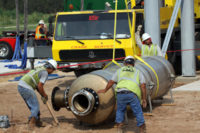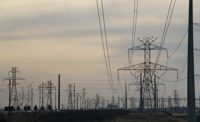Across central New Mexico and southern Arizona, the largest U.S. renewable energy infrastructure project is taking shape. When completed, Pattern Energy Group’s $11-billion SunZia Wind and Transmission project will deliver power from a 3,515-MW wind farm spanning 550 miles to grid connections for the West.
Pattern estimates that SunZia will supply 3 million people with clean power each year. Most of them would likely be in Arizona and California, where demand is high for renewable energy but developing wind projects can be difficult from a permitting perspective, says Derek Price, senior vice president of Pattern’s EPC group.
New Mexico, where the onshore wind component of the project is being built, is uniquely situated for “greening the nights” in the West because the wind typically picks up in New Mexico as the sun is setting further west, Price adds.

SunZia’s transmission line is being supported by more than 2,100 structures that include a mix of lattice towers and monopoles.
Image courtesy Pattern Energy
“So then we’re importing more renewable energy into the state as the sun’s going down and they have a shortage of power, so they don’t have to re-fire fossil fuel plants as much during the evening hours,” he says.
Pattern plans to finish work and begin operating the wind farm in 2026.
The wind portion of SunZia is being built across parts of Torrance, Lincoln and San Miguel counties in New Mexico. Plans call for 916 turbines, including 2.4 GW worth from GE Vernova and 1.1 GW from Vestas. Pattern decided to source turbines from two suppliers to mitigate risk in light of the project’s scale, Price says. The orders represent the largest yet for Vestas’ latest high-capacity factor turbine as well as the largest to date for GE Vernova’s onshore wind turbines, according to the suppliers.
“You can get overwhelmed looking at the sheer size and scale of it.”
—Derek Price, Senior Vice President, Pattern Energy
“We wanted to manage our risk and split up the supply,” Price says. “I think our suppliers felt the same thing too, because it puts a lot of risk in their basket as well if something happened with our project financing or the project was delayed and all of a sudden they’ve got 3.5 GW worth of turbines they can’t deliver on.”
Construction, which began last fall, is proceeding on schedule, with the team ready to start accepting turbine deliveries from GE Vernova this summer and from Vestas early next year. Construction is currently underway for every phase of the project, says Todd Bell, vice president of construction at Pattern. Civil grading work is nearly done, about half of the foundations for the transmission structures are complete and close to a fifth of the structures are already installed. Stringing activities started last month. High-voltage direct current (HVDC) converter stations are under construction, and equipment for them, such as capacitors and transformers, is being manufactured.
On the transmission side, the 550 miles of 525-kV HVDC lines will be supported by 2,162 structures, including a mix of lattice towers and monopoles from several suppliers. They vary in size, and each is engineered for needed clearances and the varying terrain, Bell says.
“It’s not an off-the-shelf item,” he says.

With the project broken into smaller segments, Pattern meets regularly with contractors and craftworkers to keep them updated on challenges, progress and expectations.
Image courtesy Pattern Energy
Lessons Learned
Pattern’s team underwent a sort of dress rehearsal for SunZia with its earlier Western Spirit project, which included just over 1 GW of installed wind capacity in central New Mexico and a 150-mile transmission line. Working in the same region for SunZia, Price says the team is implementing lessons learned on Western Spirit for the current project.
“We’ve been working on these building blocks over the years,” he says. “We didn’t just go from building small wind projects to all of a sudden building this mega wind project. We’ve actually been preparing for this for about a decade now.”
For the larger SunZia project, Price says Pattern brought in more internal resources for areas such as environmental expertise and cost controls, and the firm is in the process of implementing new construction project management systems to better track spending, risks and contractual obligations.

Some of the remote parts of the jobsite are most easily reached by helicopter.
Image courtesy Pattern Energy
The contracting team also retains some experience from the Western Spirit project. There are four major EPC contracts for SunZia, Bell says. The first, held by Quanta Services Inc., is for the transmission line poles and wires. A second contract with a consortium of Quanta and Hitachi Energy Ltd. covers construction of the HVDC stations in Arizona and New Mexico. There also are two contracts with Blattner Co., a subsidiary of Quanta that worked on Western Spirit, for the wind facility.
SunZia’s size presents its greatest challenges. To deal with the hurdles, the team broke the transmission line into three segments and the wind farm into 10 zones, each managed as its own smaller job with its own team as part of the larger project.

Pattern’s team is applying experience from its earlier, smaller wind and transmission project in New Mexico.
“You can get overwhelmed looking at the sheer size and scale of it,” Price says. “We were very intentional very early to create coordination agreements amongst all of our major contractors and suppliers.”
Those smaller pieces make it easier to manage safety, and Bell says the team is also focused on communication between the different segments, contractors and suppliers. He leads a coordination committee with the different project management teams, and Pattern regularly meets with its contractors to ensure everybody understands they are part of something bigger. That focus on communication also includes recognition of the many craftworkers on the site—currently about 1,300, and Bell expects close to 2,500 at peak.
“It’s essential to make sure that we’re sharing lessons learned and everyone understands the greater project,” Bell says.

More than 1,300 craftworkers are on the project, and the job will see close to 2,500 at peak.
Image courtesy Pattern Energy
Long Development Process
The process of getting SunZia to construction was a long one. The project was in development for more than a decade before Pattern acquired it in 2022. The permitting process required numerous federal, state and local approvals. And even this year opponents filed a lawsuit challenging the Bureau of Land Management’s (BLM) approval in 2015 of the transmission line route. In April a federal judge denied the request to block construction, although an attorney for the plaintiffs said they plan to appeal.
BLM officials signed off on a final approval for SunZia about a year ago, which cleared work to begin. The Biden administration has touted the project as a part of its economic and clean energy goals, anticipating lowered energy bills and increased resilience against extreme weather.
“To tackle the climate crisis and bring clean, affordable, reliable power to American families, we need to build high-performance transmission projects like this one all across the country,” John Podesta, senior adviser to the president on clean energy, said last year when SunZia broke ground.
“It’s essential to make sure that we’re sharing lessons learned and everyone understands the greater project.”
—Todd Bell, Vice President of Construction, Pattern Energy
It’s not just the wind farm that plays into the administration’s climate goals. SunZia’s transmission line is a big part of what makes it such an important project. Price says transmission has been one of the bigger hurdles the renewable energy sector has faced because the population that will consume the energy is not necessarily located where the renewable resource is most available.
“This really is a monumental project for the [renewable energy] industry,” Price says.
Pattern has also projected SunZia will have widespread economic benefits across the region, totaling an overall expected impact of $20.5 billion, according to a study conducted by research firm Energy, Economic & Environment Consultants LLC. The majority of that economic benefit—an estimated $16.2 billion—is projected as coming from the project’s capital and operational expenditures, plus payments to private landowners. But the researchers also anticipate indirect and induced benefits from the purchase of items and services such as food and lodging, benefits to public services and schools and direct payments including taxes to public entities.
“This is something that everyone who worked on the project is going to be able to talk about for the rest of their lives,” Bell says.




![The SunZia transmission line will deliver 3,000 MW of wind power to 2.5 million customers in the West. Credit Pattern Energy[4] copy.jpg The SunZia transmission line will deliver 3,000 MW of wind power to 2.5 million customers in the West. Credit Pattern Energy[4] copy.jpg](https://www.enr.com/ext/resources/2022/07/26/The-SunZia-transmission-line-will-deliver-3,000-MW-of-wind-power-to-2.5-million-customers-in-the-West.--Credit-Pattern-Energy%5b4%5d-copy.jpg?height=200&t=1659615957&width=200)

Post a comment to this article
Report Abusive Comment